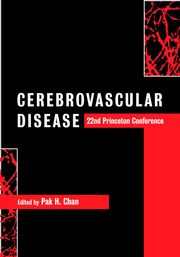Book contents
- Frontmatter
- Contents
- List of contributors
- Preface
- Acknowledgments
- Part I Special lectures
- Part II Oxidative stress
- Part III Apoptosis
- Part IV Hot topics
- Part V Hemorrhage, edema and secondary injury
- 14 The role of matrix metalloproteinases and urokinase in blood–brain barrier damage with thrombolysis
- 15 Does brain nitric oxide generation influence tissue oxygenation after severe human subarachnoid hemorrhage?
- 16 Tissue plasminogen activator and hemorrhagic brain injury
- 17 Dynamics of infarct evolution after permanent and transient focal brain ischemia in mice
- Part VI Inflammation
- Part VII Gene transfer and therapy
- Part VIII Neurogenesis and plasticity
- Part IX Magnetic resonance imaging in clinical stroke
- Part X Risk factors, clinical trials and new therapeutic horizons
- Index
- Plate section
16 - Tissue plasminogen activator and hemorrhagic brain injury
from Part V - Hemorrhage, edema and secondary injury
Published online by Cambridge University Press: 02 November 2009
- Frontmatter
- Contents
- List of contributors
- Preface
- Acknowledgments
- Part I Special lectures
- Part II Oxidative stress
- Part III Apoptosis
- Part IV Hot topics
- Part V Hemorrhage, edema and secondary injury
- 14 The role of matrix metalloproteinases and urokinase in blood–brain barrier damage with thrombolysis
- 15 Does brain nitric oxide generation influence tissue oxygenation after severe human subarachnoid hemorrhage?
- 16 Tissue plasminogen activator and hemorrhagic brain injury
- 17 Dynamics of infarct evolution after permanent and transient focal brain ischemia in mice
- Part VI Inflammation
- Part VII Gene transfer and therapy
- Part VIII Neurogenesis and plasticity
- Part IX Magnetic resonance imaging in clinical stroke
- Part X Risk factors, clinical trials and new therapeutic horizons
- Index
- Plate section
Summary
Effects of tissue-type plasminogen activator in acute clinical stroke
A rational approach to cerebral ischemia involves reperfusion of occluded arteries. Recent clinical trials have shown that thrombolytic therapy with tissue-type plasminogen activator (tPA) may be effective for acute ischemic stroke. However, there is also an elevated risk of cerebral hemorrhage and further brain injury. In all three of the major clinical trials (National Institute of Neurological Disorders and Stroke, European Cooperative Acute Stroke Study I and II), the odds ratio for intracerebral hemorrhage after tPA therapy was increased by about three-fold compared with placebo. The precise mechanisms that underlie these negative effects of tPA remain unclear, but are clearly related to severity of the ischemic insult as well as to the timing of tPA-induced reperfusion. In this chapter, the literature on the neurotoxic effects of tPA will be briefly discussed, and data from our own laboratory will be provided with which we examine some of these mechanisms.
Effects of tPA in experimental cerebral ischemia
Although tPA-induced reperfusion of ischemic brain tissue is expected to salvage tissue, recent reports from the experimental literature have suggested that tPA may have neurotoxic effects as well. Wang and colleagues have shown that infusion of tPA increased infarct size in a mouse model of focal cerebral ischemia. Potentially negative effects of tPA may be based on its ability to activate plasminogen and induce damaging extracellular proteolytic pathways. Specifically, non-fibrin substrates for plasmin, such as laminin, may be degraded.
- Type
- Chapter
- Information
- Cerebrovascular Disease22nd Princeton Conference, pp. 181 - 191Publisher: Cambridge University PressPrint publication year: 2002



